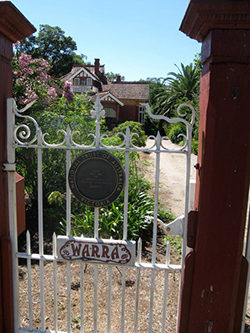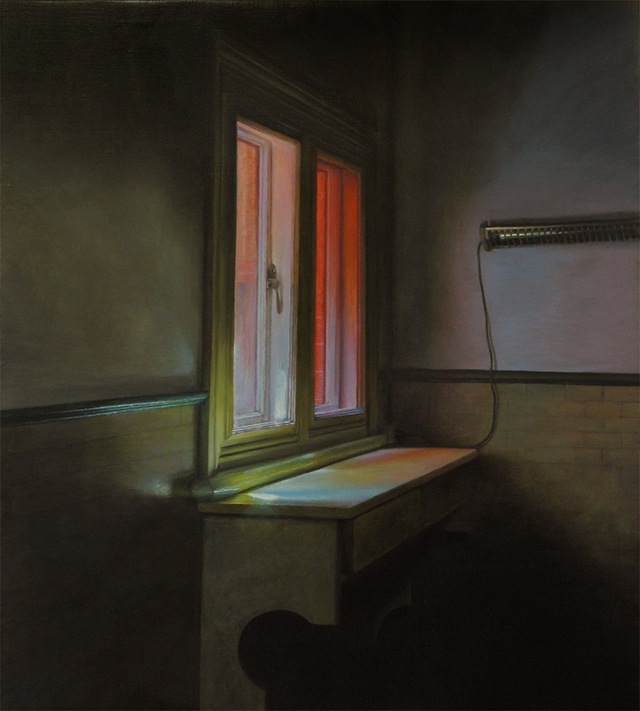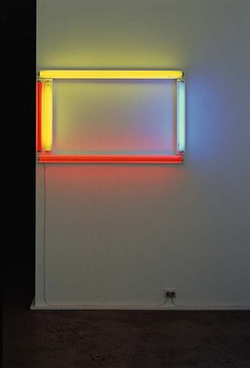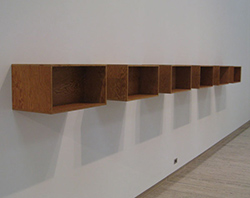< SOLO 2018
ELECTRIC LIGHT
Winner of the Gainsborough Greens Art Award in 2012.
Electric Light | Scott Bennett | 2011 | Oil on linen | 36″x40″ | Private collection
Artist’s Statement
“In a very dark chamber, at a round hole, about one third part of an inch, broad, made in the shut of a window, I placed a glass prism, whereby the beam of the Sun’s light, which came in at that hole, might be refracted upwards toward the opposite wall of the chamber, and there form a coloured image of the Sun. – Sir Isaac Newton“
Having just moved into Warra alone, as artist in residence, I was nervous of the big empty home. I found myself looking carefully into its darkened spaces, afraid I might see something! The house has proved completely benign, almost as if those potential ghosts were working hard to make my experience ‘normal’. This lack of spectres has been replaced by the phenomena of perception, by the mystery of seeing itself. In the darkest part of the house I looked by chance into the old bathroom. For a moment the appearance was of an arrangement of artificial lights, ‘image-objects’ after Dan Flavin. At another moment the furnishings’ spatial dimensions structured the void to become objects, like Donald Judd’s more specific ones. My associations are ironic, because I have only ever seen photographs of these works, never in real life, in real space. And that is a problem, as the Minimalist proposal rejected the notion of represented space.
Read more
“Three dimensions are real space. That gets rid of the problem of illusionism and of literal space, space in and around marks and colors, – which is riddance of one of the salient and most objectionable relics of European art. – Donald Judd“
Yet the currency of visual Art, the real value of exchange, resides in its documentation. For visual works this documentation in the form of reproductions is unavoidable. But can ‘real space’ ever be other than its own representation. This is an existential dilemma. Subject and object can’t transcend their relation to each other, by definition. Like the problem of epistemic loneliness, in which according to Sartre, any apparent unity (With the other) is self-deception; an “illusion of fusion”.
‘The eyes are the window of the soul’ is a variant form of a very early proverb. Quoted by Cicero (106-43B BC). ‘The face is a picture of the mind as the eyes are its interpreter’ (Ut imago est animi voltus sic indices oculi). The French say, ‘The eyes are the mirror of the soul’ (Les yeux sont le miroir de l’âme). The later biblical saying (AD 58 to 68) is similar ‘The light of the body is the eye: therefore if your eye is single, your whole body will be full of light – (Matthew 6:22-23)*’
A window is etymologically a ‘wind eye’ an opening in a dwelling. The Old Norse word vindauga, replaced the Old English words eagbyrl, literally eye-hole and eagduru meaning eye-door. It has been known for at least two thousand years that when light passes through a small hole into a dark, enclosed interior, an inverted image will appear on the wall opposite the hole. The empirical fact that an image can be produced in this way is the origin of the camera obscura, Latin for ‘dark chamber’. Thinkers as remote from each other as Euclid, Aristotle, Alhazen, Roger Bacon, Leonardo, and Kepler noted this phenomenon and speculated in various ways how it might or might not be analogous to the functioning of human vision.
In Latin, camera originally meant ‘vaulted room’ It came from Greek kamárā ‘vault, arch’, which reached English, via Old French chambre, as chamber, and is preserved in the legal Latin phrase – in camera – ‘privately, in judge’s chambers’. Cabinet has the same roots, Its modern political sense derives from a 17th-century usage ‘private room’ in which the sovereign’s advisors or Cabinet Council met.
*My “modern” (2022) translation of the of the KJV Bible. I’ve never liked the Old English version I’d quoted when I first wrote this.

Warra residency
In February 2011 Scott moved to Wangaratta in Victoria to take up residency in ‘Warra’ the family home of the artist June Tupicoff.
© Dan Flavin
a primary picture
1964
Red, yellow, and blue fluorescent light
2 ft (high) x 4 ft (wide) /61 x 122 cm/
I’m a fan of Dan Flavin. This particular work reminds me of my own Electric Light; specifically.
Specific Objects
Untitled installation
Donald Judd
1975
Douglas Fir plywood in six units
I can’t claim to have never seen Donald Judd’s Specific Objects in real space anymore. I saw some at the AGNSW yesterday (Nov 2012); oh well! 😉



